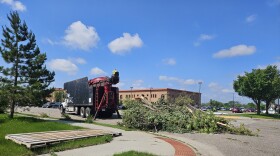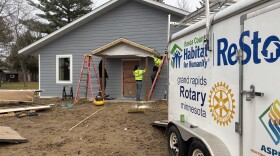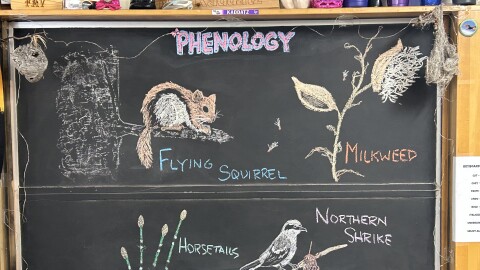BEMIDJI — Bemidjians — both proper and from surrounding communities — are faced with overwhelming damage from a severe storm that brought winds over 100 mph on Saturday June 21, devastating trees, power poles and structures alike.
Tens of thousands were without power in the immediate aftermath, and some still have yet to have their electricity restored as of Monday.
Below is a list of resources and answers compiled by the KAXE News Team to try to make the information you need as accessible as possible.
Don't see an answer to a question you're asking? Email us at news@kaxe.org. We'll update this story as more information becomes available.
When will I get power back?
- Beltrami County: All but a handful of Beltrami Electric Cooperative customers had power back as of Thursday morning. View the Outage Map for more information.
Bemidji: Around 230 Otter Tail Power Co. customers were still without power as of Thursday morning. "We’re nearly there, but we know that for those still without power, it doesn’t feel fast enough," a Wednesday statement read. "We’re doing everything we can to reach every last home and business in all the communities we serve."
A social media post from the company has restored power to most neighborhoods, but repairs continue for nested outages at individual locations. View the Outage Map for more information.
If you encounter downed power lines, stay away and assume they are charged. If you smell natural gas, call 911.

What do I do with storm debris?
The Department of Natural Resources recommends piling your storm debris, but not burning it until this fall.
"Green branches and logs won’t burn, can create smoky conditions and any heat can hold over only to reignite the pile later, creating wildfire concerns," the DNR said in an announcement.
The Bemidji Fire Department also warns against burning.
City residents can instead bring leaves, branches and logs to the nearest city street — without blocking the roadway — for pickup. No construction debris, stumps or other waste will be collected.
Northern Township is also conducting curbside pickup of tree debris of 8-foot or smaller branches.
Solid Waste extended demolition landfill hours and expanded to a second location. The field behind Target at 2115 23rd St. NW is now equipped to accept tree debris, and opened 9 a.m. Tuesday. This location will ONLY accept tree debris.
Both the permanent Demolition Landfill and the temporary location will be open Tuesday-Saturday this week from 7 a.m.-7 p.m.

According to officials, there have been numerous inquiries about if the county will provide curb pick-up of debris, but it will not. Private property owners outside of the city are responsible for the removal of their debris, and no pickup will be conducted.
The Leech Lake Band of Ojibwe said tribal police is taking calls from Band members for help removing downed trees at 218-335-8277.
The police crisis response manager is also available to assist members with resources related to housing and displacement, food replenishment, transportation and more. Call or text between 8 a.m. and 4:30 p.m. Monday through Friday, 218-317-3611.
Also, be careful of storm cleanup scammers trying to take advantage of you. The Bemidji Fire Department recommends you:
- Pause before you pay. Don’t give money to anyone without verifying their identity and legitimacy.
- Get multiple estimates. Reputable contractors won’t pressure you or demand cash on the spot.
- Check credentials. Make sure they’re licensed and insured with the city of Bemidji.
- Trust your instincts. If it feels off, it probably is.
What roads or places are closed because of the Bemidji storms?
- The Bemidji Post Office retail counter reopened Wednesday, June 25. Rural and city delivery have been happening since Monday, but have experienced delays due to debris and removal efforts.
- Bemidji State University will remain closed through Sunday, June 29, as the school continues to prepare for a safe and secure return to campus. For the safety and security of campus employees, the public is asked to not come to the BSU campus during the closure.
- Northwest Technical College reopened Thursday, June 26. Information and guidance will be shared with employees and students as needed.
- Lake Bemidji State Park will be closed until 4 p.m. Friday, June 27. Most park trails will be closed indefinitely. The park hopes to reopen Bog Walk Trail next week. The fishing pier is closed, and access to the boat launch/marina is blocked.
- Much of Itasca State Park has reopened. The Wilderness Drive scenic road remains closed until debris is cleared. Backcountry hiking trails have not been assessed. The Mary Gibbs Cafe will reopen Friday, June 27. The Douglas Lodge Restaurant will reopen Saturday.
- Bemidji area forest roads are being cleared using heavy equipment. The Department of Natural Resources discourages travel on storm-impacted forest roads.
- Many area trails have been severely impacted and are currently impassable, including Paul Bunyan State Trail between Lake Bemidji State Park and Nary.
- Public water accesses affected by the storm are now open.

How does the disaster declaration process work?
Christopher Muller, Beltrami County emergency management director, shared a statement on social media explaining the process following a disaster:
My intent is to provide context and why things seem to be moving slowly and why certain resources are not being utilized.
First, one of the fundamentals of Emergency Management is that disaster starts and ends locally. We, as the community, are responsible for the response to disasters in our community and we grow the response as needed. This includes requesting mutual aid and additional resources. We do not sit around and wait for someone else to take it over.
When disasters exceed our capabilities we start with mutual aid, often from neighboring agencies or partners we work with. When mutual aid is exhausted we can request state resources. Typically, a state of emergency is declared to allow for an expedited response by opening additional resources to support the efforts to recover from disaster. A state of emergency does not immediately award the county access to funding or resources.
Depending on the incident or disaster, state resources may be requested. Once the incident is stabilized, data is collected by Emergency Management and costs are estimated. Depending on the estimated total to respond to the disaster or loss, the county can request a Preliminary Damage Assessment (PDA) to determine eligibility for state or federal reimbursement assistance.
To qualify for FEMA assistance, the State of Minnesota has a threshold of $10.7M of PUBLIC INFRASTRUCTURE damage or response cost. That total comes from local governments, such as Beltrami County. Beltrami County must also meet a threshold of $218,000. Once that threshold is met, the county needs to declare a state of emergency. After declaring, the request then goes to the Minnesota Homeland Security and Emergency Management (HSEM). HSEM will conduct a PDA to confirm eligibility of damages for reimbursement. Upon verifying the threshold is met, the county will request the Governor to declare the county a disaster area.
If the state meets the federal threshold with a combination of a county or counties, they can request a PDA from FEMA. Following a similar process as above, except the state goes to FEMA, the Governor will request the President declare Minnesota as a major disaster area. This process can take time, especially if it is uncertain if the thresholds will be met. Funding comes in the way of reimbursement assistance to the local governments.
In Minnesota, there is a state program called the Disaster Assistance Contingency Account (DACA). DACA serves two purposes in Minnesota. The first is in the situation where Minnesota is declared a major disaster area. Eligible applicants (counties/tribes/other public entities) receive 75% reimbursement from FEMA. DACA covers the other 25% so the applicants are reimbursed 100% for eligible activity/damage. The second is when the state does not meet the FEMA threshold, is denied a major disaster declaration or the local jurisdiction falls short of the threshold but exceeds 50% of the threshold. Then DACA provides 75% reimbursement to the applicant with the remaining 25% being the local jurisdiction’s cost.
The process can be confusing, and it does take time. As far as calls for the National Guard to be deployed, there is another process for that. Normally reserved for the protection of life and property, this disaster has transitioned into clearing debris. There are a number of resources assisting, and if you need assistance please contact the Community Resources Connections or unitedwaybemidji.org. Thank you to the many volunteers and relief organizations that are supporting our community.
Yes, I will acknowledge that the role of FEMA has some uncertainty, but I’m not here to speculate. I’ve been through many disasters; this is certainly the biggest and most impactful. This is a natural disaster, and we all feel like the victim. It is understandable we want to find something to blame this on, but we need not blame someone. I said this quote at the Board meeting on Monday, and I’ll repeat it again: “We always say that we don't want that dark day. It was a dark morning, but then the sun came up, the clouds cleared, and we came together, and we're going to continue to move together.”
What if I don't have Wi-Fi or cell service near Bemidji?
T-Mobile said teams are on the ground in Bemidji to help the community stay connected. Starting at 2 p.m. Monday, T-Mobile began offering free Wi-Fi and device charging. Community members are welcome to stop by anytime. The Bemidji Commons T-Mobile store location will be open 24 hours a day, but this may change. The address is 2219 Paul Bunyan Drive NW.
How can I help the Bemidji community? What if I need help?
United Way of Bemidji and Community Resource Connections are providing services and resources to connect volunteers and those in need. Volunteers should call 218-444-8929 or visit the United Way Bemidji website. Those needing assistance can call 218-333-0880 or visit crcinform.org.
The Northwest Minnesota Foundation is directing donations to its disaster recovery fund and the United Way of Bemidji Area's relief fund.
- Bemidji area donations: http://bit.ly/4k0lEAl
- Regional donations: http://bit.ly/4eb2PsE
To bolster on-the-ground efforts, Northwest Minnesota Foundation said it is contributing $30,000 in emergency funding: $15,000 to the United Way of Bemidji Area’s newly established Disaster Relief Fund and another $15,000 to strengthen the foundation's own Northwest Minnesota Emergency Disaster Recovery Fund.
Staff from Oshkiimaajitahdah in Redby is accepting donations until 3 p.m. June 26 for Bemidji residents affected by the storm. The items will be distributed at the Oshkiimaajitahdah-Bemidji office from 4 p.m. to 7 p.m. the same day.
What's going on with the Red Cross shelter?
The Assistance Center closed the overnight shelter as of Monday, June 23, as clients have been able to return to their pre-disaster accommodations or alternative arrangements have been made.
The Community Resources Center will be open 11 a.m. to 6 p.m. daily, with hot meals, shelf-stable supplies and more resources available through Wednesday, July 2.
What's going on with the Bemidji Regional Airport?
Flights are back on schedule at the Bemidji Regional Airport, according to Lakeland PBS.
The storm damaged some of the airplanes, including two with collapsed landing gear and at least two damaged by the hangar either partially or fully on top of them.
The airport lost power for almost two days due to the storm as well as generator malfunctions. The power is now back, and the airport is operational.
What happened to cause so much damage?
National Weather Service Grand Forks meteorologist Jacob Spender said the weather service saw the potential for a derecho — a large, fast-moving thunderstorm with straight-line winds — as the system started to form in eastern Montana.
Crews conducted preliminary damage surveys over the weekend, and additional staff were in the area Monday.
"We were looking for any kind of damage indicator to kind of determine, 'Was there a potential tornado in this? Or was this all just widespread wind damage?'" Spender said.
"And the preliminary findings from this is, looking at that, it potentially was just the widespread nature of the wind damage and it being so forceful and so strong across that area."
A wind gust of 106 miles per hour was recorded at the Bemidji Regional Airport, and the weather service estimates gusts reached between 100 and 120 miles per hour, between a Category 2 and a Category 3 hurricane.
Spender has worked on the East Coast and compared what he saw in Bemidji as part of the survey crew to hurricane damage.
He said the scale of the event itself stuck out to him.
"When you came into Bemidji itself, you saw a couple trees that were down, but then all of a sudden, you saw the brunt force of it," he said. "It was almost a 10 to almost a 20-mile wide swath of damage."
Spender said large-scale wind events aren't entirely uncommon — one moved through the area in 2022.
"But seeing this widespread damage and these high winds like that — they can be a rarity," he said.
-
During the week of Nov. 18, 2025, we enjoy reports of new ice, Northern Lights, and a close-up look at a shrike's (in)digestion. Staff phenologist John Latimer responds.
-
-
The Brainerd lakes area organization's mission is to end homelessness and lift people out of poverty. Its Creekside Community continues to expand. Donations are being accepted to help furnish new homes.
-













